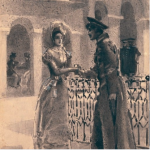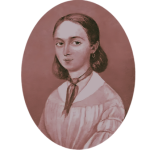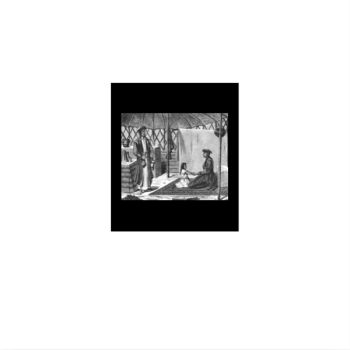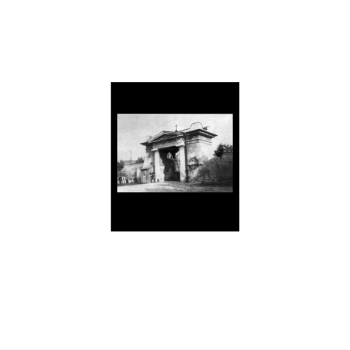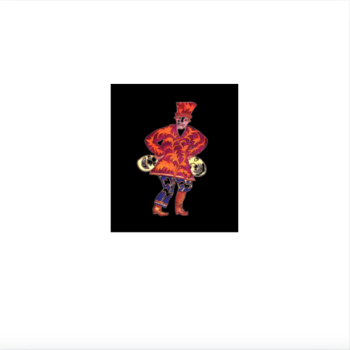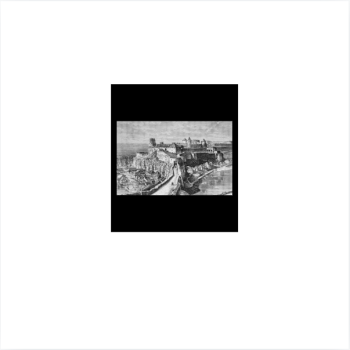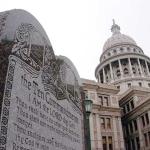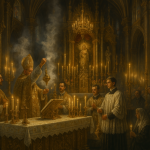Winter Palace
Having arranged for his family to stay at the waters, Andrei Mikhailovich left Pyatigorsk on June 23 for Stavropol to carry out assignments regarding state property. Soon after, the famous Molokan Mennonite. Johann Cornies came to Stavropol specifically to visit and see him.[1] He was a remarkable man whom Andrei Mikhailovich loved and respected very much. Having arrived in Russia about twenty years earlier from Prussia, a complete pauper, and worker, Cornies managed in short order to cultivate a huge fortune for himself through his activity and intelligence. More importantly, he managed to bring much benefit to his community and all the neighboring residents, including the Nogais, by his example, instructions, and material assistance.
Having stayed in Stavropol for about two weeks, he then went to inspect first the Russian state property of that province, and then the Kalmyk steppes, where the Kalmyks (of both Derbetovsky uluses) were nomadic. He took Cornies with him, and together they traveled along the Manych and Kuma Rivers, near the borderland of the Don Host, through the entire Kalmyk steppe lying in that direction, and staying overnight in their nomadic camps. In these nomadic camps, he found a Kalmyk a nobleman, Dzhambo-Gelyung, who, though never having been anywhere except his steppes, still managed to form for himself the concept of a settled economy, built a house, started a mill, and farmed. The other Kalmyks did not follow his example, although there were many places there that were very convenient for settlement.[2]
In this direction, Andrei Mikhailovich finally reached the first Russian settlement of Aksai, in the Astrakhan province, and then through the ulus of the Maloderbetovsky he reached Sarepta. He made a detailed description of the entire area he had traveled, and upon completion of the review in the Astrakhan Province of everything that had been entrusted to him, he presented the most detailed information to the ministry, including his opinion on the best arrangement in this province for fishing industries. He made similar descriptions for the Stavropol and subsequently for the Saratov Province.
In Sarepta, he spent a very pleasant day walking, inspecting the useful and interesting institutions of the Moravian village. In conversation with the elders, an American missionary, and Cornies, with whom he parted the next day. Cornies went back to Molochnye Vody, and Andrei Mikhailovich went down the Volga, from Sarepta to Astrakhan, to inspect the government settlements on both banks. In the first days of August, he returned to Astrakhan and spent the entire month occupied with the accumulated papers. At the end of the month, he went to the government villages, again down the Volga, to the sea estuary, for a few days, and on the evening of September 7, he was delighted by the return of Elena Pavlovna, his daughters, and granddaughters, from Pyatigorsk.
He did not have much time to stay with them, however, since he had to hit the road again on September 24, to inspect the Saratov colonies and then to go to St. Petersburg with his reports. It was bitter to part with all his people, which was almost certainly going to be for a long time. Helena Andreevna accompanied him to Sarepta, where she and the girls reunited with Pyotr Alekseevich who was quartered in Kursk Province. Andrei Mikhailovich went to inspect the Saratov colonies on both banks of the Volga from Kamyshin to Volzhsk. Having reached the colony of Sevastyanovka, forty miles from Saratov, along the right bank of the Volga, he crossed to the left. Not far from Kamyshin, he saw a remarkable place near the colony of Shcherbanovka. Four miles from the Volga, a high, steep ravine was formed, overgrown with forest, in the depths of which there was a narrow, longitudinal valley with a fast river. The colonists built more than twenty water mills in this valley, with small but beautiful houses and gardens. This presented a very picturesque and original scene. He found the colonies on the left bank of the Volga much more organized and at a higher level of prosperity than on the mountainside (which was due to the surplus of land on the steppe side, while on the mountainside the colonists felt a strong shortage of it.) He already found the well-known colony “Katerinenstadt” quite organized, but more in the form of an industrial and commercial settlement than an agricultural colony.
Having surveyed all the colonies in detail, he arrived in Saratov on October 13, where he spent two weeks collecting the information he needed for his report in the Office of Foreign Settlers. In this report, he presented the Ministry with detailed information, both on the state of the Saratov colonies and proposals for measures to improve their well-being. In these colonies, the Germans had been so spoiled for forty years, before the reign of Emperor Alexander, and so morally corrupted, that in 1803, the late Tsar Alexander Pavlovich ordered the establishment of eight houses of correction in them. Andrei Mikhailovich found these colonists somewhat improved (in terms of morality,) but there were still many disorders and all kinds of trouble. His main assumptions were, firstly, to organize their land ownership, which was in complete chaos. (Many landowners were far from their lands and did not endow them with enough money, while others were over-endowed, etc.) His second goal was to divide the lands by families among the landowners and confirm them in undivided hereditary ownership. Thirdly, he wanted to provide allotments in plots only to one owner-plowmen, and not to merchants and industrialists. And finally, he aimed to assist those who, due to the rapid increase in population needed means of provision and resettle them in places of the Empire where there was still a great surplus of land. He set out for St. Petersburg at the end of October with his two assistants, Neidgard and Frank. Their road was the worst and the weather most miserable, but in the company of two intelligent, educated young men, Andrei Mikhailovich spent his time quite pleasantly.
They dragged themselves through the frozen mud and slush for more than two days, and only on the third did they reach Penza, where they stayed with a relative of Elena Pavlovna. Having had a good rest with him, the next day, after a hearty dinner, they went along the road to Kutlya, spent the night there, and in the morning they attended a memorial service in the church at the grave of the late Prince Pavel Vasilyevich and continued their journey.
The road and the weather became increasingly worse; the snow and rain did not stop, and they traveled day and night. Andrei Mikhailovich began to get tired and found their journey very unpleasant, but an unexpected little adventure occurred, which provided them with some entertainment. They were traveling in two carriages; Neidgard and the official named Biller rode in one, while Frank and Andrei Mikhailovich rode in the other. There were two people with them, a valet and the cook Ivan. One station short of Murom, a wheel broke in Neidgard’s carriage, and they had to stop at the station to wait for it to be repaired. Out of boredom, they sat down to play cards. In the meantime, a carriage drove up to the station, and a traveler got in, a decent-looking man, who introduced himself to them as a certain Penza landowner, one of the prominent nobles of the city.
He told them that he was traveling from Moscow and was in a great hurry to Penza, where his family, whom he had not seen for a long time, and important business awaited him. After talking a little, he went into another room and, returning a few minutes later, announced that he liked them so much, and being much pleased with them, he did not wish to part with them. To prolong this pleasure, he decided to go back to Moscow with them. It seemed to them rather unusual that a family man, elderly, businesslike, traveling along such a bad road and having already covered half of it, wanted to go back for such a strange reason, but out of politeness, they said that they were very glad. And indeed, the old man sent the manager who was with him to settle affairs in the village, and he, turning the shafts, went with them to Moscow. They found in him a very kind and amiable companion, who entertained them all the way: in Moscow he took them to his place, right to his apartment, received them excellently, fed and gave them drink, mainly champagne, and every day brought them a ticket to a box at the theatre (which Andrei Mikhailovich did not use.) Only once did this eccentric drag him to the theatre, where he sat for about an hour and a half. They were showing Kukolnik’s Prince Skopin-Shuisky.[3] The play did not amuse Andrei Mikhailovich, but he was amused by two scenes in the neighboring boxes. In one, behind the ladies and young ladies, a maid of enormous stature in a printed dress stood stretched out behind the young ladies the entirety of the performance. In the other box, there were seated provincial visitors. Andrei Mikhailovich assumed so, at least, calculated from the number of their persons. There was not enough seating for everyone in the box, so they brought benches under their cloaks. The legs of these benches turned out to be unreliable, and in the first act the legs on one of the benches gave way, and the lady fell. Her loud “ah!” resounded throughout the theatre. Andrei Mikhailovich left more pleased with this performance in the box than on the stage.
The incomprehensible trick of their hospitable host finally became clear. It seems that when the Penza landowner met them at the station, he recognized the cook Ivan as one of the former people of Prince Pavel Vasilyevich, who had grown up and always lived in Penza. The landowner began to ask Ivan about Penza news, and Ivan, among other things, told him scandalous gossip about the landowner’s wife. This had such an effect on him that, without thinking twice, he instantly changed his route and rushed forward back to Penza.
Andrei Mikhailovich had found Governor Timiryazev in Moscow, he arrived from Astrakhan to present himself to Tsar Nicholas Pavlovich, hoping to receive a higher appointment. If this proved successful, he wanted Andrei Mikhailovich to serve under him. Three days later they left Moscow, and on November 13 they arrived in St. Petersburg. Of course, Andrei Mikhailovich immediately went to Rostya, whom he found healthy, very grown, and having passed the exam for admission to the 3rd grade of the artillery school with distinction. In the following days, during his official presentations, Andrei Mikhailovich learned from Count Kiselev about his proposed appointment to the newly opened administration of the Saratov Chamber of State Property; but the time for the execution of this proposal had not yet been determined. Meanwhile, he had plenty of work in St. Petersburg. His main occupations consisted of finishing his reports on the Kalmyks, colonists, and state settlers of the Astrakhan and Saratov provinces, and then in meetings of the commission established by Count Kiselev to hear reports on the state of state property from officials. For this purpose, the reports were sent to all the provinces of the Empire. These amounted to huge reams of papers; they expressed views on the incompetence of officials. Indeed, there were many curiosities in these reports, but there were also some useful tidbits, and, in general, taken all together, constituted rich material for understanding the life of the state peasants of that time. Andrei Mikhailovich was not sure if Count Kiselev read even the briefest extracts from them; he, like all the ministers of the time (except Count Georg Ludwig Cancrin,) was content with superficial views and his own biased conclusions, adapting them to the same theoretical wishes of the Sovereign Emperor. Count Cankrin once said that Count Kiselev was not a realist, but rather a formalist, adding that there were very few of the former in Russia and very many of the latter. In intimate conversations, Count Cankrin said that Count Kiselev wanted to use up more of himself than he had material for.
Governor Timiryazev, who was then in Petersburg, was cut from the same cloth as Count Kiselev. He also bothered Andrei Mikhailovich with assignments to draw up various impracticable projects like, among other things, converting Kalmyks into a Cossack army (following the example of the Don and Ural armies.) The idea was perhaps excellent from a military point of view, but not entirely practical, especially after the government had made a positive decision to establish the Kalmyks as peaceful settlers. Another project, which particularly interested him had as little chance of success as the previous one, namely, to establish a town at the Kalmyk Bazaar, four miles from Astrakhan, on the Petersburg Highway. This was where the Kalmyk fair for trading in cattle had been established since the time before the Kalmyk Exodus when the Kalmyk existed as one people. There were only a few inns left there now. Plans had already been prepared for this purpose, estimates were being made Governor Timiryazev was already consoled by the hope of becoming the founder of the future Kalmyk capital. But, fortunately or unfortunately, there was no possibility of carrying out this enterprise, due to the lack of money needed for expenses, and so everything ended in nothing but lengthy conversations. In his free hours from study, Andrei Mikhailovich spent most of his time with Rostya and Pavel Mikhailovich, who was then a member of the artillery department. He was a rare man, both in his natural intelligence and in his abilities.
Everyone who knew him knew Pavel Mikhailovich as such. He did not make a particularly long career only because he was not inquisitive and always told the truth. Several times during his life, having occupied good positions that promised him a brilliant future, he, despite the resistance of his superiors, left these positions, indeed, even the service itself, because he could not bear the cruelties, injustices, strictness, of which he was necessarily forced to be an involuntary tool, executor, or simply a witness. Following unswervingly the dictates of his conscience and noble, soft heart, he brought upon himself the wrath and disgrace of the higher-ups who valued him as a capable, businesslike, and infinitely honest man. This is why he refused a prominent position under Count Alexey Andreyevich Arakcheev and the position of chief of the Tula Arms Factories (which greatly angered Grand Duke Mikhail Pavlovich and forced him to temporarily retire.) With such an independent course of action, of course, Pavel Mikhailovich could not arrange his material well-being, but he did not particularly care about it, he was never despondent and always put up with all the circumstances of life, content with the impeccability of his conscience and service and the respect of all honest people.
Andrei Mikhailovich often visited Pavel Mikhailovich’s former superior, the famous General Baron Karl Fyodorovich Lowenstern, a kind man, and famous gastronome, who lived out his days in retirement with the rank of member of the military council. All the Petersburg nobility came to him to indulge in epicurean dinners, and at the same time made fun of his weaknesses, of which, after gluttony, the predominant one was his inordinate ambition. He regarded himself a completely statesmanlike person and was angry with Count Kiselev for having taken the Ministry of State Property away from him. Disappointed in his ambitious thoughts, he finally gave himself over to a passion for food. He often invited Andrei Mikhailovich to dine with him, always announcing some special dish with which he intended to treat him (and most importantly himself,) like Westphalian ham boiled in Madeira, or pheasant stuffed with truffles, etc. After dinner, Baron Lowenstern usually took Andrei Mikhailovich with him in his carriage to see ballets. (Baron Lowenstern was also somewhat partial to ballets.) At a performance of “The Danube Maiden,” the famed dancer, Marie Taglioni, jumped so high that she nearly touched the ceiling.[4] He did not stay long, and usually after the first act, he went home to drink tea with Rostya whom he could never persuade to go to the theater, even occasionally. His son preferred sitting over mathematics and military history.
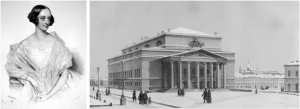
(Left) Marie Taglioni. (Right) The Bolshoi Theatre late 1830s.
Sometimes Baron Lowenstern did not trust his cooks and went to the market himself to choose provisions and check prices; he would put on some old overcoat, taking measures so that he would not be recognized. But on more than one occasion, not only in St. Petersburg but also in the provinces, his clandestine maneuvers were compromised. In St. Petersburg he went to the market, disguising his general’s uniform as best he could, and bought two fat, well-fed live geese. He took them both under his arms and carried them home by the shortest route, forgetting that there was a guardhouse on the way. As soon as he drew level with it, the sentry on duty recognized him and called the guard. The frightened general, wanting to stop the sentry, waved his hand in a hurry, and one of the geese immediately broke free and ran. Baron Lowenstern rushed to catch it, and then the other goose jumped out from under his hand and followed his comrade. At the same time, the sentry under arms saluted the artillery general, Baron Lowenstern, silently contemplating why the General was rushing from one goose to another in confusion. All the while, the geese, flapping their wings, fought off the representative Russian army with loud quacks. After such an incident, Baron Lowenstern never went to the market to buy geese again. Many jokes were told about him, and perhaps not all of them were true, but in any case, they accurately depicted his character.
At the same time, Andrei Mikhailovich became acquainted with the metallurgist Petr Grigorievich Sobolevsky, who became very famous for a time in Russia for introducing the platinum coin (and for developing platinum in general.) His daughter, Natalya Petrovna Sobolevskaya, was the wife of Andrei Mikhailovich’s nephew, Alexander Alexandrovich.[5] An intelligent and amiable old man, Petr Grigorievich lived like a great gentleman. He had a rich dacha on Petrovsky Island with an excellent gallery of paintings, statues, bronzes, and all sorts of rarities; and hosted excellent dinners with the choicest wines. His house was heated by some special chemical method. For a non-scientist like Andrei Mikhailovich, it seemed terribly cold in the rooms, and he was glad when dinner ended at eight o’clock in the evening to quickly get home to warm up.
Many events occurred in St. Petersburg at this time, the most remarkable of which was the terrible fire that raged in St. Petersburg on December 17 and 18 and destroyed the Winter Palace. The spectacle was terrible and astonishing. The majestic stone mass, engulfed in flames, burst out in fiery columns from the windows and roof. The people of the city could hear the sound of falling ceilings and walls. A bloody, crimson glow hovered above the site of the fire, and the smoke covered the entire sky. Confusion reigned in the palace. The wealth of all families, collected during the reign of ten Tsars, perished in the flames; jasper vases, marbles, bronzes, expensive parquet floors, wallpaper, mirrors. The soldiers, detached to save everything that could be saved, instead broke into the cellars and from there rushed in drunken crowds into the inner chambers, where, for their own amusement, they beat and broke everything they came across. The whole square was dotted with whole heaps of piled-up things. A strong wind increased the force of the fire and, when it blew, the sea of fire parted and groups of statues, blackened by smoke, appeared at the top of the flames, like spirits or fiery salamanders. Half the fire brigade (according to rumors) never returned. To top it all off, in one huge hall, where a whole company of Izmailovsky Life Guards was crowded, the ceiling suddenly collapsed and buried dozens of people under burning brands. Twenty thousand guards and probably more than a hundred thousand people were helpless witnesses to this terrible event. Finally, when they saw that it was impossible to extinguish the fire, the order was given to leave the palace. It burned for three days, surrounded by troops bivouacked on the square. When it was all over, thousands of precious little things were piled up in heaps, as too were the charred logs and many corpses who perished under their rubble.[6]
-
- NOVOROSSIYA
- The Arbiter Of Europe’s Destiny.
- The House Dolgorukuy
- Madame Krüdener
- Ekaterinoslav
- The Arabat Arrow
- The Mystery Of General Inzov
- The Doukhobors
- Pushkin
- Chuguev Military Settlement
- “The Blessed”
- The Decembrists
- Penza
- Independence
- Last Words Of Samuel Khristianovich Kontenius
- “Amid Coffins And Desolation”
- Rusalka
- Dead Souls
- Secret Passages
- Astrakhan
- Nevsky Prospekt
- Kalmyk Ulus
- Love And Ambition
- Duellistes
- Pyatigorsk
- A Heroine Of Our Time
- Winter Palace
- Zeneida R-Va
- Steppes
- Letter To Natalya
- Fire And Ice
SOURCES:
[1] One of the richest colonists, Cornies had sent his son to school in St. Petersburg. After completing his studies, Cornies ordered him to first go to Astrakhan and introduce himself to Andrei Mikhailovich, and only then return to his parents’ house. [Fadeyev, Andrei Mikhailovich. Vospominaniia: 1790-1867. Vysochaishe Utverzhd. Yuzhno-Russkago. Odessa, Ukraine. [Russian Empire.] (1897): Part I: 116n.
[2] The establishment of settled settlements and the cultivation of field farming, left to the Kalmyks themselves, are still proceeding very slowly and although they represent some successes, they are very insignificant in comparison with the general mass of the people and the vastness of the lands granted to them. Having understood the advantages of living in houses, some Kalmyks began to build wooden houses for their winter stays and in 1839 there were 277 of them in all the uluses. At the same time, warned by the severity of several winters, the Kalmyks began to stock up on hay and reeds for the winter. Particularly remarkable at that time was the inclination of two Kalmyk gelungs towards farming. One of them, Khara-gelung, having set up a small farmstead by the Artan-Zelmen River, which flows in a hollow between the Ergene mountain range, did not live there permanently, but only came there to supervise the agricultural work, which was carried out not by Kalmyks, but by hired peasants. But another gelung, Dzhambo, wandering to the west of Lake Tsogur, separately from the entire Maloderbetovsky Ulus, first hired Russian peasants to plow the land, and then, following their example, Kalmyks began to cultivate it, under the leadership of Dzhambo-gelung, who established a semi-settled lifestyle there. In 1839, Dzhambo – gelung sown 60 dessiatines of land with various types of grain. But in 1844, only the ruins of Dzhambo-gelung’s house testified to the fact that these places had once been liked even by Kalmyks.” [Article III in: Buhler, V. Nomadic And Settling Foreigners In The Astrakhan Province: Article I.” Otechestvennye Zapiski. No. 7 (1846); Buhler, V. Nomadic And Settling Foreigners In The Astrakhan Province: Article II.” Otechestvennye Zapiski. No. 8 (1846); Buhler, V. Nomadic And Settling Foreigners In The Astrakhan Province: Article III.” Otechestvennye Zapiski. No. 10 (1846); Buhler, V. Nomadic And Settling Foreigners In The Astrakhan Province: Article IV.” Otechestvennye Zapiski. No. 11 (1846.)]
[3] Stites, Richard. Serfdom, Society, And The Arts In Imperial Russia: The Pleasure And The Power. Yale University Press. New Haven, Connecticut. (2008): 194.
[4] “The French critiques upon [Taglioni] are written in a more intensely artistic spirit; the art of dancing is more appreciable in its subtleties by that volatile nation. Her appearance in Paris was considered to mark an epoch in the history of dancing. Then, it was said, decency and pleasure, propriety and voluptuousness, discovered that they were sisters. Marie Taglioni became the object of a culte; the critical journals adored her under the epithets of admirable, inconceivable, prodigious, inimitable, and other enthusiastic phrases which surrounded her name like an aureole and the enumeration of which would fill a volume […] After the completion of the engagement at Paris, Taglioni appeared at St. Petersburg, dancing there for the first time on the 18th Sept. 1837, and remaining in Russia until 1842 […] The Emperor Nicholas of Russia was very amiable towards her, and always came on to the stage to speak to her when she was performing. On one occasion, after she had been dancing, the Empress came to speak to her; and when, just afterwards, Nicholas came himself, he said, ‘You have seen the Empress?’ ‘Yes,’ answered Mdlle. Taglioni, ‘she has done me the honour of coming to me.’ He said, ‘She has never done this before for anyone,’ ‘What a pretty foot the Empress has,’ remarked Mdlle. Taglioni. ‘Yes,’ replied the Emperor, ‘I think she would have made a very good dancer!’ She was in Russia at the time of [Tsar Alexander II’s] betrothal; and when Nicholas came on the stage to her he said to Taglioni, ‘Congratulate me, because my son is going to marry a person of his own choice.’” [Autolycus. “Marie Taglioni, Comtesse Gilbert De Voisins.” The Dublin University Magazine. Vol. III, No. 4 (April 1879): 461-480.]
[5] Alexander Alexandrovich Fadeev (1810-1898) was the son of Alexander Mikhailovich Fadeev (d. 1824.)
[6] Fadeyev, Andrei Mikhailovich. Vospominaniia: 1790-1867. Vysochaishe Utverzhd. Yuzhno-Russkago. Odessa, Ukraine. [Russian Empire.] (1897): Part I: 132-141.


